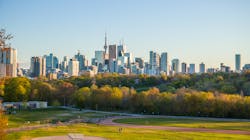New Framework Shows How Cities Across Canada Can Become “Living Cities”
Humans are intuitively drawn to the natural environment. It is the context in which we have come to evolve as humans in the first place, after all. It calls to us. It calms our nervous system. Think of the feeling you get when walking through a barren, paved parking lot on a hot summer day. Uncomfortable, maybe a bit suffocated. Then, think of the feeling of walking through a neighbourhood lined with mature trees in full bloom, birds twittering in the branches above. A feeling of relief, maybe of aliveness and connection with your surroundings.
Incredible in its own right, nature and natural processes are also actually quite useful to us. The services provided by nature—known as ecosystem services—are many: it purifies water and air, it infiltrates stormwater, it stabilizes the ground under our feet by preventing erosion, it regulates the climate.
Despite this, in modern times, we have largely built our cities as places that exist outside of nature. City and nature have come to mean near opposite things. We cut forests, clear meadows, fill wetlands, channel rivers, and build on top of what was. When we do this, we lose the gifts and services the land used to provide. However, this is not inevitable: this is a choice. A choice that has consequences. Not only does poor exposure to nature impair our physical and mental health, it also makes our cities much more vulnerable to environmental hazards like flooding and extreme heat—hazards that are becoming more frequent because of climate change.
If divorcing nature from cities is a choice, so is remarrying them. Increasingly, cities around the world are looking to protect and reintegrate nature into and amid the built environment as ways to address the climate crisis, public health disparities, and to deliver community services more efficiently. Instead of seeing nature as something that belongs outside of cities, the idea of “green infrastructure” is increasingly taking hold: a recognition that nature (and natural processes) provides our societies with several services and benefits, and the way we build our cities should reflect this. The recently released Pathways to Living Cities: A Policy and Governance Framework, a collaboration between Green Communities Canada and researchers at the University of Toronto, shows how cities around the world are doing this, and how cities in Canada can, too.
Green infrastructure (GI) includes both naturally occurring ecosystems, like woodlands, meadows and wetlands, as well as introduced vegetation like parks, gardens and street trees (this subset of green infrastructure is often referred to as “natural assets”); enhanced and engineered systems that use vegetation, like rain gardens, green roofs and naturalized stormwater ponds; and that mimic and/or complement natural processes, such as infiltration trenches or permeable pavements (also referred to as “low impact development”).
Unlike grey infrastructure — the piped systems that drain stormwater to treatment plants or directly into surface water bodies — that is designed for a single purpose, GI offers many social, economic and environmental co-benefits. It can also be much more cost-effective to implement than grey infrastructure. For example, Philadelphia, Pennsylvania, was in repeated violation of federal regulations due to combined sewer overflows releasing untreated sewage and stormwater directly into the Delaware River. The city conducted an independent economic analysis of the cost to dig up and separate stormwater and wastewater sewers compared to implementing green infrastructure to avoid overflows in the first place. The analysis revealed it would cost the city approximately $6-8 billion to dig up the sewers and about $1.6 billion over 25 years to implement an extensive GI strategy to infiltrate excess stormwater and avoid the overflows that were leading to extreme pollution events in the river. They are also finding that using green instead of just grey infrastructure to address this challenge has reaped a number of other benefits.
The Living Cities Framework showcases Philadelphia’s journey with green infrastructure, as well as other local governments across North America and Europe. The framework is unique among green infrastructure publications in that it emphasizes actionable strategies that have worked to integrate GI into city-building and place-making—a gap that was identified by many practitioners we spoke with who are working in GI-related fields across Canada. Although there are quite a few green infrastructure resources that exist in the world, many of these resources are quite specific to certain aspects of GI, such as asset management, low-impact development maintenance, etc. These resources are incredibly useful, but the project team also heard there was a need for a higher-level resource that could marry the many facets of green infrastructure implementation: from policy and planning best practices, to social considerations, to technical and operational processes. Despite many people working in GI-related fields—planning, landscape architecture, civic works, etc.—being familiar with GI and its benefits, cities still stumble to implement GI outside of isolated pilot projects. The framework provides a roadmap for municipalities to work across departments and with external partners to help them shift GI from “pilot project” to instrumental to the city-building project.
To develop the framework, the project team reviewed over 250 academic research publications, grey literature, technical and policy resources, and case studies of green infrastructure implementation. The team then synthesized all this knowledge into 17 evidence-based strategies that support local governments to advance equitable, abundant and thriving green infrastructure in their communities, and provide concrete examples and resources that help to operationalize this.
Local governments and those that they work with will be better positioned to zoom into the details of GI implementation once they understand the broader policy, social, and technical strategies that can ensure GI is equitable, abundant and thriving. This framework shows how the pieces fit together and links to a number of those pieces so that practitioners can do a “deep dive” into what they need to make it happen.
The Framework's authors hope that the document will help catalyze the shift to cities where people and nature thrive together; where diverse trees, shrubs, and flowers flourish as part of the built environment. These cities would not only be more vibrant and beautiful—they would also be much more resilient to the impacts of climate change, be healthier and more livable places, and be better able to deliver vital community services.
Christine Mettler
Christine Mettler is the Director of Green Infrastructure at Green Communities Canada. Christine has more than a decade of experience in the environmental sector, with a focus on protecting freshwater and promoting green infrastructure. Christine was a lead author of Pathways to Living Cities, a first-of-its-kind policy framework that showcases best practices, resources and case studies from across North America and Europe to help practitioners advance equitable, abundant, and thriving green infrastructure. Green Communities Canada’s Living Cities program will be scaling up significantly in 2023 in 2024, providing dedicated resources and support to communities across Canada to accelerate green infrastructure implementation.






